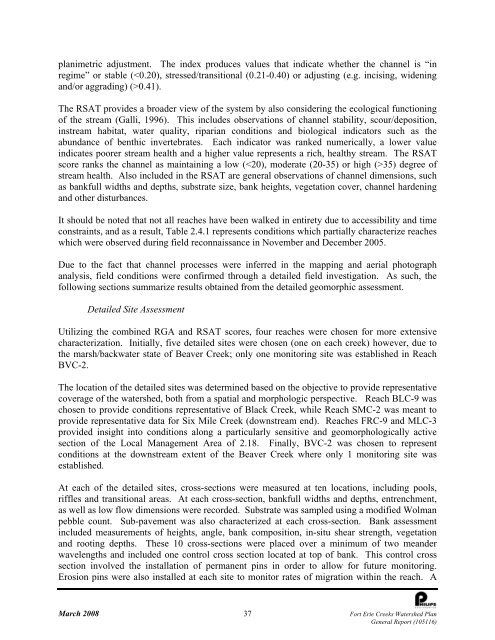Fort Erie Creeks Watershed Plan - Niagara Peninsula Conservation ...
Fort Erie Creeks Watershed Plan - Niagara Peninsula Conservation ...
Fort Erie Creeks Watershed Plan - Niagara Peninsula Conservation ...
Create successful ePaper yourself
Turn your PDF publications into a flip-book with our unique Google optimized e-Paper software.
planimetric adjustment. The index produces values that indicate whether the channel is “in<br />
regime” or stable (0.41).<br />
The RSAT provides a broader view of the system by also considering the ecological functioning<br />
of the stream (Galli, 1996). This includes observations of channel stability, scour/deposition,<br />
instream habitat, water quality, riparian conditions and biological indicators such as the<br />
abundance of benthic invertebrates. Each indicator was ranked numerically, a lower value<br />
indicates poorer stream health and a higher value represents a rich, healthy stream. The RSAT<br />
score ranks the channel as maintaining a low (35) degree of<br />
stream health. Also included in the RSAT are general observations of channel dimensions, such<br />
as bankfull widths and depths, substrate size, bank heights, vegetation cover, channel hardening<br />
and other disturbances.<br />
It should be noted that not all reaches have been walked in entirety due to accessibility and time<br />
constraints, and as a result, Table 2.4.1 represents conditions which partially characterize reaches<br />
which were observed during field reconnaissance in November and December 2005.<br />
Due to the fact that channel processes were inferred in the mapping and aerial photograph<br />
analysis, field conditions were confirmed through a detailed field investigation. As such, the<br />
following sections summarize results obtained from the detailed geomorphic assessment.<br />
Detailed Site Assessment<br />
Utilizing the combined RGA and RSAT scores, four reaches were chosen for more extensive<br />
characterization. Initially, five detailed sites were chosen (one on each creek) however, due to<br />
the marsh/backwater state of Beaver Creek; only one monitoring site was established in Reach<br />
BVC-2.<br />
The location of the detailed sites was determined based on the objective to provide representative<br />
coverage of the watershed, both from a spatial and morphologic perspective. Reach BLC-9 was<br />
chosen to provide conditions representative of Black Creek, while Reach SMC-2 was meant to<br />
provide representative data for Six Mile Creek (downstream end). Reaches FRC-9 and MLC-3<br />
provided insight into conditions along a particularly sensitive and geomorphologically active<br />
section of the Local Management Area of 2.18. Finally, BVC-2 was chosen to represent<br />
conditions at the downstream extent of the Beaver Creek where only 1 monitoring site was<br />
established.<br />
At each of the detailed sites, cross-sections were measured at ten locations, including pools,<br />
riffles and transitional areas. At each cross-section, bankfull widths and depths, entrenchment,<br />
as well as low flow dimensions were recorded. Substrate was sampled using a modified Wolman<br />
pebble count. Sub-pavement was also characterized at each cross-section. Bank assessment<br />
included measurements of heights, angle, bank composition, in-situ shear strength, vegetation<br />
and rooting depths. These 10 cross-sections were placed over a minimum of two meander<br />
wavelengths and included one control cross section located at top of bank. This control cross<br />
section involved the installation of permanent pins in order to allow for future monitoring.<br />
Erosion pins were also installed at each site to monitor rates of migration within the reach. A<br />
March 2008 37 <strong>Fort</strong> <strong>Erie</strong> <strong>Creeks</strong> <strong>Watershed</strong> <strong>Plan</strong><br />
General Report (105116)
















